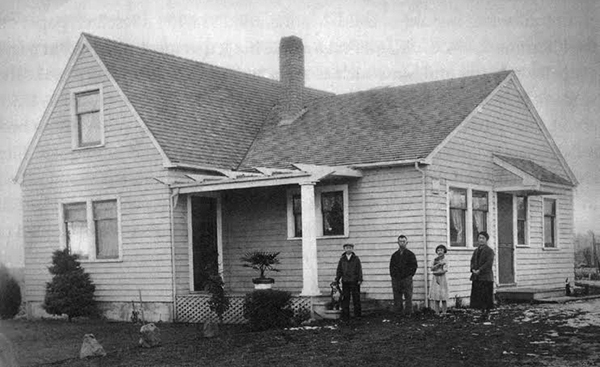BRUCE HAULMAN and TERRY DONNELLY
For The Beachcomber
The Matsuda Farm at Center, just behind the K2 facility, along with the Otsuka Farm just north of Vashon town, were the last large-scale commercial strawberry farms on Vashon. At its largest the Matsuda Farm was nearly 50 acres and sold strawberries throughout the Puget Sound region. The Vashon Maury Island Land Trust is in the process of purchasing 12 acres of this piece of Vashon’s agricultural history to assure that the farm passes from one farmer to the next, that it continues agricultural production into the future and that it provides possibilities to develop trail connections with Island Center Forest and Vashon town.
During the 1920s and 1930s, strawberries were the largest single crop produced on Vashon, and by the 1930s many of the strawberry farms on Vashon were owned or farmed by Japanese immigrants and their families. The Matsuda family is a good example of how the Japanese came to Vashon, became a part of the community, were imprisoned during World War II, returned to the island after the war and then experienced the collapse of Vashon agriculture as outside forces made commercial farming no longer viable on the island.
Heisuke and Mitsuno Matsuda, along with their American-born children Yoneichi (1923) and Mary (1925), came to Vashon in 1927 and began farming on leased land at Shawnee. In 1930, for $2,000, they purchased 10 acres at Center, built a four-bedroom house and a barn and began to develop the Matsuda Farm. Because Japanese immigrants were not allowed to become American citizens, because the anti-Japanese land laws prevented non-citizen Japanese from owning land and because Yoneichi was not yet of legal age, the Matsuda’s purchased the land in the name of Daiichi Umani, the adult, American-born son of their good friends and former employers in Fife.
During World War II, Executive Order 9066 declared the West Coast an Exclusion Zone for those of Japanese descent and directed their mass evacuation. On May 16, 1942, the Japanese on Vashon were evacuated. The Matsudas were removed and imprisoned, first at Pinedale Assembly Center, then at Tule Lake, Heart Mountain, and finally Minidoka Internment Camps. During their imprisonment, Mary joined the Cadet Nurse Corps and trained as a nurse in Clinton, Iowa. Yoneichi joined the famous all-Japanese 442nd Regimental Combat Team and fought in Italy and France, winning a bronze star for bravery under fire.
Following the war, the Matsudas returned to their Vashon farm in September 1945 and resumed growing strawberries and loganberries as their primary crops. Yoneichi joined his parents after his father was injured in an accident in May 1946 and took over management of the farm. Mary retuned to Vashon in mid-1947 and then moved to Seattle to begin her nursing career with Providence Hospital and later Group Health Coopeartive. Yoneichi successfully ran the farm while also teaching at Ingraham High School in Seattle. Yonechi was named 1957 Conservation Farmer of the Year by the King County Soil Conservation Service for his innovative work in developing storm water retention ponds. He married Marjorie in 1958 and they had four daughters. Marjorie died in 1973, and in 1977 he married Miyoko. Yoneichi and Miyoko planted their last strawberry crop in about 1981, and in 1985, after retiring from teaching and harvesting the strawberries, Yonechi suffered a heart attack and died. Miyoko continued to run the farm but did not replant strawberries. She is the last of the Matsudas living on Vashon. Mary, her children and Yoneichi’s children all live off-island.
Mary Matsuda Gruenewald has recounted her family’s experiences in her books “Looking Like the Enemy” and “Becoming Mama San,” and islander Tom Spring has developed a fine summary history of the Matsuda farm available at the land trust. The Matsuda Farm is a good example of the changes Vashon has experienced from being agricultural based economy in the early-to-mid 20th century to a commuter/service based economy in the early 21st century. From a time when land was primarily used for agriculture, to today when land is primarily used for housing and for recreation.
— Bruce Haulman is an island historian, and Terry Donnelly is an island photographer.



